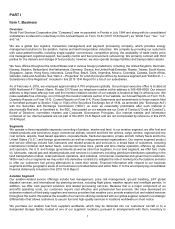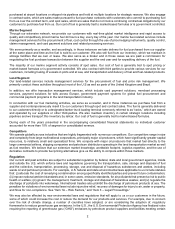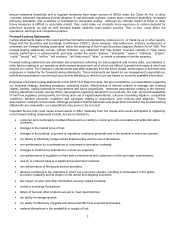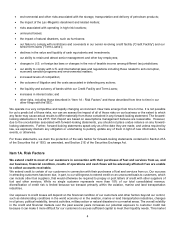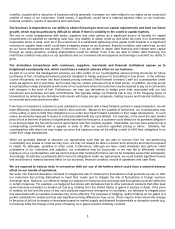World Fuel Services 2015 Annual Report Download - page 16
Download and view the complete annual report
Please find page 16 of the 2015 World Fuel Services annual report below. You can navigate through the pages in the report by either clicking on the pages listed below, or by using the keyword search tool below to find specific information within the annual report.11
•
global economic conditions;
•
changes in global crude oil and natural gas prices;
•
expected and actual supply and demand for fuel;
•
the ability or willingness of the Organization of Petroleum Exporting Countries (“OPEC”) to set and maintain
production levels for oil;
•
oil and gas production levels by non-OPEC countries;
•
geopolitical conditions;
•
laws and regulations related to environmental matters, including those mandating or incentivizing alternative energy
sources or otherwise addressing global climate change;
•
changes in pricing or production controls by various organizations and oil producing countries;
•
technological advances affecting energy consumption or supply;
•
energy conservation efforts;
•
price and availability of alternative fuels; and
•
weather.
If fuel prices increase, our customers may not be able to purchase as much fuel from us because of their credit limits with
us and the resulting adverse impact on their business could cause them to be unable to make payments owed to us for fuel
purchased on credit. They may also choose to reduce the amount of fuel they consume in their operations to reduce costs
or comply with new environmental regulations to obtain associated incentives. For example, in the shipping industry a
number of container ships sail at reduced speeds, known as “slow steaming,” to conserve fuel and reduce carbon emissions.
In any such event, there can be no assurance that the volume of orders from our customers will thereafter increase or that
we will be able to replace lost volumes with new customers. In addition, if fuel prices increase, our own credit limits could
prevent us from purchasing enough fuel from our suppliers to meet our customers’ demands or could require us to prepay
for fuel purchases which would impair our liquidity.
Conversely, extended periods of low fuel prices, particularly when coupled with low price volatility, can also have an adverse
effect on our results of operations and overall profitability. This can be due to a number of factors, including decreased
demand for our services and price risk management products. Low fuel prices also facilitate increased competition by
reducing financial barriers to entry and enabling existing, lower-capitalized competitors to conduct more business as a result
of lower working capital requirements.
Finally, we maintain fuel inventories for competitive or logistical reasons. Because fuel is a commodity, we have no control
over the changing market value of our inventory. Our inventory is valued using the average cost methodology and is stated
at the lower of average cost or market. A rapid decline in fuel prices could cause our inventory value to be higher than
market, resulting in our inventory being marked down to market or the inventory itself sold at lower prices. While we attempt
to mitigate these fluctuations such as these through hedging, there can be no assurance that such hedges will be effective.
Accordingly, if the market value of our inventory is less than our average cost and to the extent our hedges are not effective
at mitigating fluctuations in prices, we could record a write down of inventory on hand and a non-cash charge, which could
adversely impact our earnings.
Economic, political and other risks associated with international sales and operations could adversely affect our
business and future operating results.
Because we offer fuel products and services on a worldwide basis, our business is subject to risks associated with doing
business internationally. Our business and future operating results could be harmed by a variety of factors, including:
• trade protection measures and import, export and other licensing requirements, which could increase our costs or
prevent us from doing certain business internationally;
• the costs of hiring and retaining senior management for overseas operations;
• difficulty in staffing and managing widespread operations, which could reduce our productivity;
• unexpected changes in regulatory requirements, which may be costly and require significant time to implement;
• laws restricting us from repatriating profits earned from our activities within foreign countries, including the payment
of distributions;
• governmental actions that may result in the deprivation of our contractual rights or the inability to obtain or retain
authorizations required to conduct our business;
• political risks specific to foreign jurisdictions; and


